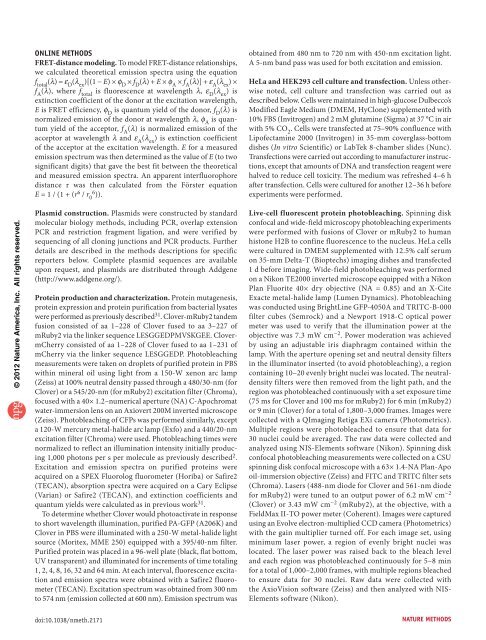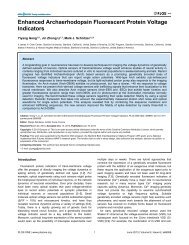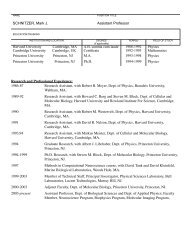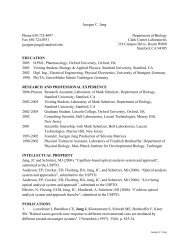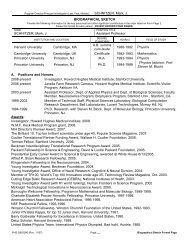improving Fret dynamic range with bright green and red fluorescent ...
improving Fret dynamic range with bright green and red fluorescent ...
improving Fret dynamic range with bright green and red fluorescent ...
- No tags were found...
Create successful ePaper yourself
Turn your PDF publications into a flip-book with our unique Google optimized e-Paper software.
ONLINE METHODSFRET-distance modeling. To model FRET-distance relationships,we calculated theoretical emission spectra using the equationf total(λ) = ε D(λ ex)[(1 − E) × φ D× f D(λ) + E × φ A× f A(λ)] + ε A(λ ex) ×f A(λ), where f totalis fluorescence at wavelength λ, ε D(λ ex) isextinction coefficient of the donor at the excitation wavelength,E is FRET efficiency, φ Dis quantum yield of the donor, f D(λ) isnormalized emission of the donor at wavelength λ, φ Ais quantumyield of the acceptor, f A(λ) is normalized emission of theacceptor at wavelength λ <strong>and</strong> ε A(λ ex) is extinction coefficientof the acceptor at the excitation wavelength. E for a measu<strong>red</strong>emission spectrum was then determined as the value of E (to twosignificant digits) that gave the best fit between the theoretical<strong>and</strong> measu<strong>red</strong> emission spectra. An apparent interfluoropho<strong>red</strong>istance r was then calculated from the Förster equationE = 1 / (1 + (r 6 / r 0 6 )).obtained from 480 nm to 720 nm <strong>with</strong> 450-nm excitation light.A 5-nm b<strong>and</strong> pass was used for both excitation <strong>and</strong> emission.HeLa <strong>and</strong> HEK293 cell culture <strong>and</strong> transfection. Unless otherwisenoted, cell culture <strong>and</strong> transfection was carried out asdescribed below. Cells were maintained in high-glucose Dulbecco’sModified Eagle Medium (DMEM, HyClone) supplemented <strong>with</strong>10% FBS (Invitrogen) <strong>and</strong> 2 mM glutamine (Sigma) at 37 °C in air<strong>with</strong> 5% CO 2. Cells were transfected at 75–90% confluence <strong>with</strong>Lipofectamine 2000 (Invitrogen) in 35-mm coverglass-bottomdishes (In vitro Scientific) or LabTek 8-chamber slides (Nunc).Transfections were carried out according to manufacturer instructions,except that amounts of DNA <strong>and</strong> transfection reagent werehalved to <strong>red</strong>uce cell toxicity. The medium was refreshed 4–6 hafter transfection. Cells were cultu<strong>red</strong> for another 12–36 h beforeexperiments were performed.© 2012 Nature America, Inc. All rights reserved.Plasmid construction. Plasmids were constructed by st<strong>and</strong>ardmolecular biology methods, including PCR, overlap extensionPCR <strong>and</strong> restriction fragment ligation, <strong>and</strong> were verified bysequencing of all cloning junctions <strong>and</strong> PCR products. Furtherdetails are described in the methods descriptions for specificreporters below. Complete plasmid sequences are availableupon request, <strong>and</strong> plasmids are distributed through Addgene(http://www.addgene.org/).Protein production <strong>and</strong> characterization. Protein mutagenesis,protein expression <strong>and</strong> protein purification from bacterial lysateswere performed as previously described 31 . Clover-mRuby2 t<strong>and</strong>emfusion consisted of aa 1–228 of Clover fused to aa 3–227 ofmRuby2 via the linker sequence LESGGEDPMVSKGEE. ClovermCherryconsisted of aa 1–228 of Clover fused to aa 1–231 ofmCherry via the linker sequence LESGGEDP. Photobleachingmeasurements were taken on droplets of purified protein in PBS<strong>with</strong>in mineral oil using light from a 150-W xenon arc lamp(Zeiss) at 100% neutral density passed through a 480/30-nm (forClover) or a 545/20-nm (for mRuby2) excitation filter (Chroma),focused <strong>with</strong> a 40× 1.2–numerical aperture (NA) C-Apochromatwater-immersion lens on an Axiovert 200M inverted microscope(Zeiss). Photobleaching of CFPs was performed similarly, excepta 120-W mercury metal-halide arc lamp (Exfo) <strong>and</strong> a 440/20-nmexcitation filter (Chroma) were used. Photobleaching times werenormalized to reflect an illumination intensity initially producing1,000 photons per s per molecule as previously described 2 .Excitation <strong>and</strong> emission spectra on purified proteins wereacqui<strong>red</strong> on a SPEX Fluorolog fluorometer (Horiba) or Safire2(TECAN), absorption spectra were acqui<strong>red</strong> on a Cary Eclipse(Varian) or Safire2 (TECAN), <strong>and</strong> extinction coefficients <strong>and</strong>quantum yields were calculated as in previous work 31 .To determine whether Clover would photoactivate in responseto short wavelength illumination, purified PA-GFP (A206K) <strong>and</strong>Clover in PBS were illuminated <strong>with</strong> a 250-W metal-halide lightsource (Moritex, MME 250) equipped <strong>with</strong> a 395/40-nm filter.Purified protein was placed in a 96-well plate (black, flat bottom,UV transparent) <strong>and</strong> illuminated for increments of time totaling1, 2, 4, 8, 16, 32 <strong>and</strong> 64 min. At each interval, fluorescence excitation<strong>and</strong> emission spectra were obtained <strong>with</strong> a Safire2 fluorometer(TECAN). Excitation spectrum was obtained from 300 nmto 574 nm (emission collected at 600 nm). Emission spectrum wasLive-cell <strong>fluorescent</strong> protein photobleaching. Spinning diskconfocal <strong>and</strong> wide-field microscopy photobleaching experimentswere performed <strong>with</strong> fusions of Clover or mRuby2 to humanhistone H2B to confine fluorescence to the nucleus. HeLa cellswere cultu<strong>red</strong> in DMEM supplemented <strong>with</strong> 12.5% calf serumon 35-mm Delta-T (Bioptechs) imaging dishes <strong>and</strong> transfected1 d before imaging. Wide-field photobleaching was performedon a Nikon TE2000 inverted microscope equipped <strong>with</strong> a NikonPlan Fluorite 40× dry objective (NA = 0.85) <strong>and</strong> an X-CiteExacte metal-halide lamp (Lumen Dynamics). Photobleachingwas conducted using BrightLine GFP-4050A <strong>and</strong> TRITC-B-000filter cubes (Semrock) <strong>and</strong> a Newport 1918-C optical powermeter was used to verify that the illumination power at theobjective was 7.3 mW cm −2 . Power moderation was achievedby using an adjustable iris diaphragm contained <strong>with</strong>in thelamp. With the aperture opening set <strong>and</strong> neutral density filtersin the illuminator inserted (to avoid photobleaching), a regioncontaining 10–20 evenly <strong>bright</strong> nuclei was located. The neutraldensityfilters were then removed from the light path, <strong>and</strong> theregion was photobleached continuously <strong>with</strong> a set exposure time(75 ms for Clover <strong>and</strong> 100 ms for mRuby2) for 6 min (mRuby2)or 9 min (Clover) for a total of 1,800–3,000 frames. Images werecollected <strong>with</strong> a QImaging Retiga EXi camera (Photometrics).Multiple regions were photobleached to ensure that data for30 nuclei could be averaged. The raw data were collected <strong>and</strong>analyzed using NIS-Elements software (Nikon). Spinning diskconfocal photobleaching measurements were collected on a CSUspinning disk confocal microscope <strong>with</strong> a 63× 1.4-NA Plan-Apooil-immersion objective (Zeiss) <strong>and</strong> FITC <strong>and</strong> TRITC filter sets(Chroma). Lasers (488-nm diode for Clover <strong>and</strong> 561-nm diodefor mRuby2) were tuned to an output power of 6.2 mW cm −2(Clover) or 3.43 mW cm −2 (mRuby2), at the objective, <strong>with</strong> aFieldMax II-TO power meter (Coherent). Images were captu<strong>red</strong>using an Evolve electron-multiplied CCD camera (Photometrics)<strong>with</strong> the gain multiplier turned off. For each image set, usingminimum laser power, a region of evenly <strong>bright</strong> nuclei waslocated. The laser power was raised back to the bleach level<strong>and</strong> each region was photobleached continuously for 5–8 minfor a total of 1,000–2,000 frames, <strong>with</strong> multiple regions bleachedto ensure data for 30 nuclei. Raw data were collected <strong>with</strong>the AxioVision software (Zeiss) <strong>and</strong> then analyzed <strong>with</strong> NIS-Elements software (Nikon).doi:10.1038/nmeth.2171nature methods


